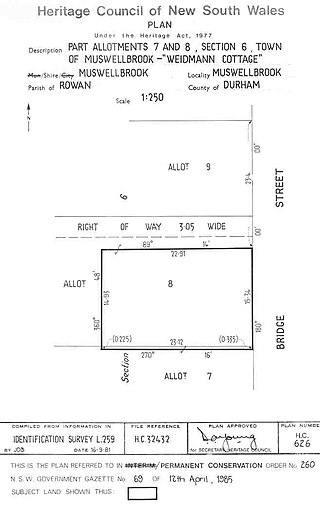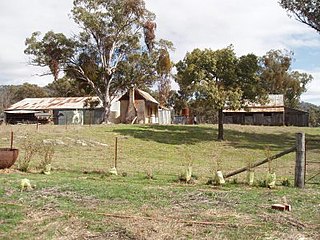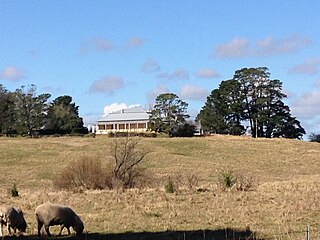
Muswellbrook is a town in the Upper Hunter Region of New South Wales, Australia, about 243 km (151 mi) north of Sydney and 127 km (79 mi) north-west of Newcastle.
Denman is a small town in New South Wales, Australia, in Muswellbrook Shire. It is on the Golden Highway in the Upper Hunter Region, about 250 kilometres (160 mi) north of Sydney. At the 2021 census, Denman had a population of 1,547.

Muswellbrook railway station is a heritage-listed railway station located on the Main Northern line in Muswellbrook, in the Muswellbrook Shire local government area of New South Wales, Australia. The station serves the town of Muswellbrook and was designed by John Whitton, the Chief Engineer of NSW Railways. It is also known as Muswellbrook Railway Station and yard group and Musclebrook Railway Station. The property was added to the New South Wales State Heritage Register on 2 April 1999.

Muswellbrook Shire is a local government area in the Upper Hunter region of New South Wales, Australia. The Shire is situated adjacent to the New England Highway and the Hunter railway line.

Baerami is a locality in the Muswellbrook Shire in the Upper Hunter region of New South Wales, Australia.

Cooma Cottage is a heritage-listed former farm and tuberculosis sanatorium and now house museum and historic site in the Southern Tablelands region of New South Wales in Australia. It is located on Yass Valley Way at Marchmont and was built from 1830 to 1837 by Cornelius and Rebecca O'Brien. It is also known as Hamilton Hume's House,Humedale Stud, and New Nordrach Institute for Consumption. The property is owned by the National Trust of Australia (NSW). It was added to the New South Wales State Heritage Register on 1 March 2002.

Cadmans Cottage or Cadman's Cottage is a heritage-listed former water police station and sailor's home and now visitor attraction located at 110 George Street in the inner city Sydney suburb of The Rocks in the City of Sydney local government area of New South Wales, Australia. The property is owned by Department of Planning & Environment, an agency of the Government of New South Wales. It was added to the New South Wales State Heritage Register on 2 April 1999.

Saumarez Homestead is a heritage-listed homestead located at 230 Saumarez Road, Armidale in the Armidale Regional Council local government area of New South Wales, Australia. The homestead was designed by J. W. Pender in the Federation Edwardian style and built between 1888 and 1906 by H. E. Elliott, while the garden was established by Mary White. The property is currently owned by the National Trust of Australia (NSW), who operate it as a museum and function venue. The homestead was added to the New South Wales State Heritage Register on 1 March 2002.

Bulimba House is a heritage-listed detached house at 34 Kenbury Street, Bulimba, Queensland, Australia. It was designed and built by Andrew Petrie from 1849 to 1850. It is also known as Toogoolawah. It was added to the Queensland Heritage Register on 21 October 1992. A number of timber cottages were constructed around the main house.

James Cobb White was an Australian grazier and politician, predominantly in New South Wales.

Glengarry Homestead is a heritage-listed homestead at Gladstone-Monto Road, Boynedale, Gladstone Region, Queensland, Australia. It was built from c. 1894 to c. 1920. It was added to the Queensland Heritage Register on 21 October 1992.

The Grange and Macquarie Plains Cemetery are a heritage-listed homestead and cemetery at 3249 O'Connell Road, Bathurst, Bathurst Region, New South Wales, Australia. It was built from 1830 to 1836, probably by convict labour. It was added to the New South Wales State Heritage Register on 15 March 2013.
The Avoca Homestead Complex is a heritage-listed former station homestead and station facilities and now catered accommodation and visitor attraction at 1122a Low Darling Road, Wentworth, in the Far West region of New South Wales, Australia. It was built between 1871 and 1879. It is also known as the Avoca Station Homestead and outbuildings. It was added to the New South Wales State Heritage Register on 8 April 2016.
The Rosedale Cottage is a heritage-listed residence at Mount Street, Murrurundi, Upper Hunter Shire, New South Wales, Australia. It was built from 1845 to 1850. The property is privately owned. It was added to the New South Wales State Heritage Register on 2 April 1999.

Weidmann Cottage is a heritage-listed former retail building, residence and town house and now unused building located at 132 Bridge Street, Muswellbrook in the Muswellbrook Shire local government area of New South Wales, Australia. It was built from 1840 to 1845. The property is owned by Muswellbrook Shire Council and was added to the New South Wales State Heritage Register on 2 April 1999.

Edinglassie is a heritage-listed farm and homestead located at 710 Denman Road, Muswellbrook in the Muswellbrook Shire local government area of New South Wales, Australia. It was built from 1880 to 1895. It was added to the New South Wales State Heritage Register on 2 April 1999.

Rous Lench is a heritage-listed farm and homestead located at Denman Road, Muswellbrook in the Muswellbrook Shire local government area of New South Wales, Australia. It was built from 1875 to 1895. It was added to the New South Wales State Heritage Register on 2 April 1999.

Binnawee Homestead is a heritage-listed disused homestead at 111 Lester's Lane, Mudgee, Mid-Western Regional Council, New South Wales, Australia. It was built from 1850 to 1900. It was added to the New South Wales State Heritage Register on 9 June 2009.

Throsby Park is a heritage-listed homestead at Church Road, Moss Vale, Wingecarribee Shire, New South Wales, Australia. It was built from 1820 to 1836. The property is owned by the Historic Houses Trust of New South Wales, but is leased to banker Tim Throsby of Barclays, a descendant of the original owners. It was added to the New South Wales State Heritage Register on 2 April 1999.
Wambo Homestead is a heritage-listed disused homestead at Warkworth, Singleton Council, New South Wales, Australia. It was built from 1830 to 1906. It was added to the New South Wales State Heritage Register on 2 April 1999.


















